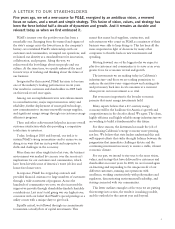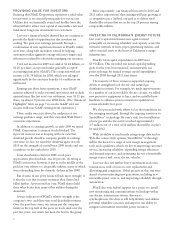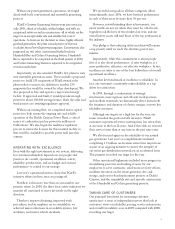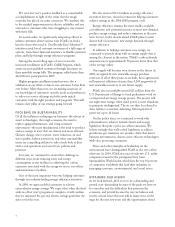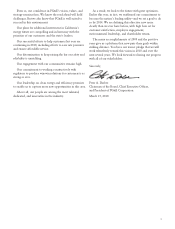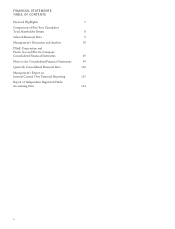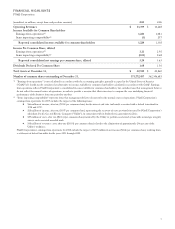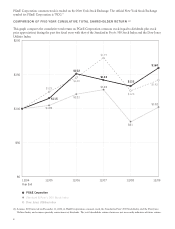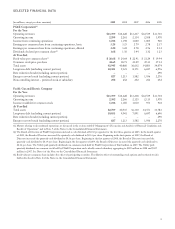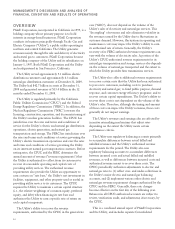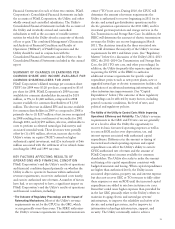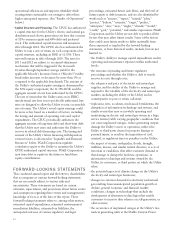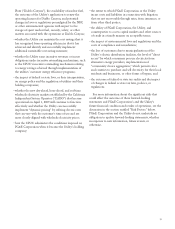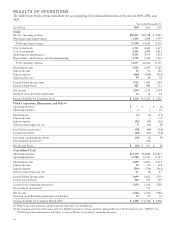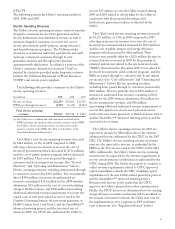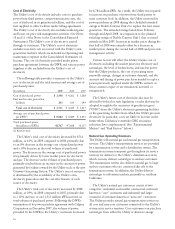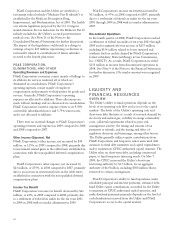PG&E 2009 Annual Report Download - page 15
Download and view the complete annual report
Please find page 15 of the 2009 PG&E annual report below. You can navigate through the pages in the report by either clicking on the pages listed below, or by using the keyword search tool below to find specific information within the annual report.Financial Statements for each of these two entities. PG&E
Corporation’s Consolidated Financial Statements include
the accounts of PG&E Corporation, the Utility, and other
wholly owned and controlled subsidiaries. The Utility’s
Consolidated Financial Statements include the accounts of
the Utility and its wholly owned and controlled
subsidiaries as well as the accounts of variable interest
entities for which the Utility absorbs a majority of the risk
of loss or gain. This combined Management’s Discussion
and Analysis of Financial Condition and Results of
Operations (“MD&A”) of PG&E Corporation and the
Utility should be read in conjunction with the
Consolidated Financial Statements and the Notes to the
Consolidated Financial Statements included in this annual
report.
SUMMARY OF CHANGES IN EARNINGS PER
COMMON SHARE AND INCOME AVAILABLE FOR
COMMON SHAREHOLDERS FOR 2009
PG&E Corporation’s diluted earnings per common share
(“EPS”) for 2009 were $3.20 per share, compared to $3.63
per share for 2008. PG&E Corporation’s 2009 income
available for common shareholders decreased by $118
million, or 9%, to $1,220 million, compared to 2008
income available for common shareholders of $1,338
million. The decrease in diluted EPS and income available
for common shareholders in 2009 as compared to 2008 is
primarily due to (1) $257 million of net income recognized
in 2008 resulting from a settlement of tax audits for 2001
through 2004, and (2) $59 million, after tax, attributable to
costs to perform accelerated natural gas leak surveys and
associated remedial work. These decreases were partially
offset by (1) a $91 million, after tax, increase due to the
Utility’s return on equity (“ROE”) earned on higher
authorized capital investment, and (2) a tax benefit of $66
million associated with the settlement of tax refund claims
involving the 1998 and 1999 tax years.
KEY FACTORS AFFECTING RESULTS OF
OPERATIONS AND FINANCIAL CONDITION
PG&E Corporation’s and the Utility’s results of operations
and financial condition depend primarily on whether the
Utility is able to operate its business within authorized
revenue requirements, recover its authorized costs timely,
and earn its authorized rate of return. A number of factors
have had, or are expected to have, a significant impact on
PG&E Corporation’s and the Utility’s results of operations
and financial condition, including:
•The Outcome of Regulatory Proceedings and the Impact of
Ratemaking Mechanisms. Most of the Utility’s revenue
requirements are set by the CPUC in the GRC, which
occurs generally every three years. The FERC authorizes
the Utility’s revenue requirements in annual transmission
owner (“TO”) rate cases. During 2010, the CPUC will
determine the amount of revenue requirements the
Utility is authorized to recover beginning in 2011 for its
electric and natural gas distribution operations and its
electric generation operations in the 2011 GRC, and for
its natural gas transportation and storage services in the
Gas Transmission and Storage Rate Case. In addition, the
FERC will determine the amount of electric transmission
revenues the Utility can recover beginning in March
2011. The decisions issued in the three associated rate
cases will determine the majority of the Utility’s revenue
requirements for 2011 and future years. (See “Regulatory
Matters” below for a discussion of the Utility’s 2011–2013
GRC, the 2011–2014 Gas Transmission and Storage Rate
Case, the 2011 TO rate case, and other proceedings.) In
addition, the Utility frequently files separate applications
requesting the CPUC or the FERC to authorize
additional revenue requirements for specific capital
expenditure projects such as new power plants, new or
upgraded natural gas or electric transmission facilities, the
installation of an advanced metering infrastructure, and
other infrastructure improvements. (See “Capital
Expenditures” below.) The outcome of these regulatory
proceedings can be affected by many factors, including
general economic conditions, the level of rates, and
political and regulatory policies.
•The Ability of the Utility to Control Costs While Improving
Operational Efficiency and Reliability. The Utility’s revenue
requirements in the GRC and TO rate case are generally
set at a level to allow the Utility the opportunity to
recover its basic forecasted operating expenses as well as
to earn an ROE and recover depreciation, tax, and
interest expense associated with authorized capital
expenditures. Differences in the amount or timing of
forecasted and actual operating expenses and capital
expenditures can affect the Utility’s ability to earn its
CPUC-authorized rate of return and the amount of
PG&E Corporation’s income available for common
shareholders. The Utility also seeks to make the amount
and timing of its capital expenditures consistent with
budgeted amounts and timing. When capital expenditures
are higher than authorized levels, the Utility incurs
associated depreciation, property tax, and interest expense
but does not recover GRC or TO revenues to fully offset
these expenses or earn an ROE until the increased capital
expenditures are added to rate base in future rate cases.
Items that could cause higher expenses than provided for
in the last GRC primarily relate to the Utility’s efforts to
maintain its aging electric and natural gas systems’
infrastructure, to improve the reliability and safety of its
electric and natural gas system, and to improve its
information technology infrastructure, support, and
security. The Utility continually seeks to achieve
11


